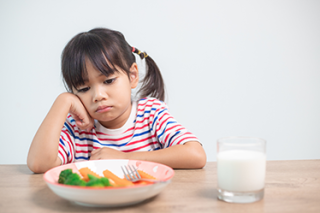Food Availability and Toddlers
Explore Other Kids and Climate Health Impacts
Find information on how climate change can affect food security and safety and children’s health. Start by reading the fictional story of a toddler who is affected by food insecurity and food illness and learn how similar situations can affect kids across the country. Also get tools to help families prepare and cope with outcomes from climate-related activity. Finally, check out the regional spotlight.
Sammy's Story
Sammy's family depends on wild fish for much of its protein intake. The fish is caught in a local river, but the number of fish caught have been lower than normal in recent years. Shellfish availability has also been declining. The family’s 3-year-old daughter, Sammy, often goes hungry due to high food costs and decreased fish catch. Sammy also recently got sick after eating crab meat and her parents struggled to keep her hydrated while she was ill.

Climate Change Impacts
- Climate change negatively impacts food security, particularly in communities that rely on agriculture, fishing, or subsistence lifestyles.1
- Certain diseases caused by foodborne and waterborne pathogens are expected to increase due to climate conditions.1
- Climate change is projected to reduce the availability and affordability of nutritious food.2
Impacts on Children’s Health
- Research has shown a link between food insecurity and risk of chronic illnesses like asthma or anemia.3
- Children who are at nutritional risk have been found to have decreased academic performance and more behavioral problems.4
- Young children are at a greater risk of food poisoning due to their developing immune systems and increased risk of dehydration.
What can I do?
- DO keep nonperishable food items on hand in case of food shortages. Check expiration dates on emergency food stashes at least twice a year. Learn more about preparing emergency kits for kids and families.
- DO contact food assistance programs. Find food assistance programs.
- DO make sure all fish are cooked to an internal temperature of 145°F, and shellfish is cooked until shells open during cooking and flesh is white and opaque. Learn more about preparing safe food for children under 5 years old. (pdf)
- DO contact a health care provider if you believe your child has food poisoning.
What should I not do?
- DON'T feed raw fish or shellfish to children under the age of five. Learn more about selecting safe food for children under 5 years old. (pdf)
- Alaska is experiencing ocean warming and extreme ocean acidification, which can affect the safety and availability of shellfish.5
- Climate change has negatively impacted the harvest of marine fishes, salmon, and crab in the state.5
- Many Alaskans rely on subsistence farming, hunting, and fishing.6 Rural Alaskans are estimated to harvest almost 300 pounds of wild food each year, over 50% of which is fish.7
- Climate change is also affecting the ability to dry and store food in traditional ways, and improper food storage increases the risk of adverse health impacts resulting from consuming fish and wildlife.5
- Fish, specifically salmon, are a very important part of the diet of most subsistence-dependent communities in Alaska. Climate change has had negative effects on the survival of salmon populations.5 Most of the food purchased in the state is imported and is subject to disruptions from extreme events. One in nine Alaskans struggles with hunger on8 average, and this number is even higher in rural and Alaska Native communities.
